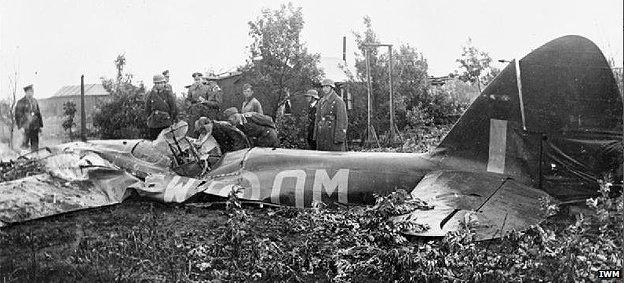Dambusters: From despair to hope
- Published

Pre-war promises of bomber dominance were destroyed by fast, well armed fighters and radar detection
At the beginning of 1942 anything of the scale or ambition of the Dambusters raid probably seemed to RAF Bomber Command like a fantasy.
At that stage of World War II commanders and crews faced two bitter truths.
Firstly, the cherished pre-war mantra of "the bomber will always get through", based on World War I experience and inter-war rhetoric, had proved illusory.
Advances in fighter and radar design had made daylight raids murderously costly in men and machines.
In one example, on 13 August 1940, 12 Blenheim bombers set out to attack a Luftwaffe airfield in Denmark. Of the 11 which made it, all were shot down, five by ground fire and six by fighters. Of the 33 crewmen who took part in the attack, 20 were killed and 13 captured.
During 1941, daylight raids consistently exceeded the 5% losses considered the maximum the air force could suffer and still function, reaching 8.4% in May and 11.8% in July.
Feeble damage
Secondly, when defences could be avoided by flying at night, raids became incredibly, almost unbelievably, ineffective.
At times it descended into black farce. In May 1940 a Yorkshire-based bomber managed to attack a fighter airfield in Cambridgeshire under the impression it was a German aerodrome in the Netherlands.
The crew had been disorientated in a storm and mistook the Thames for the Rhine. Rival squadrons sent them Iron Crosses as a joke.
To add to the sense of fiasco, an investigative team found the - unusually accurate - bomb run had done almost no damage to the airfield and therefore were presumably doing little more to the Germans.
Tami Biddle, Professor of Military History and Strategy at the US Army War College, Pennsylvania, said: "The advocates of bombing war had made a lot of promises about what it could achieve.
"They felt they had seen the future and everyone else were Luddites, they felt they could see the future and no-one else could.
"So they made the big promises and (Former Chief of the Air Staff) Trenchard said they would fly bombers over enemy cities and the people would collapse in panic under the fall of bombs.
"It was a collision of rhetoric with reality and it comes down in a big fireball. Bomber Command has to totally rebuild and retrench in 1942."
Deadly lesson
Navigation had more in common with the era of Nelson than Nazism, using stars, landmarks and educated guesswork based on speed and time.
The crunch came with the Butt Report of August 1941 - an analysis of photographs taken from bombing aircraft.
It confirmed a third of planes sent out reported being unable to find the target.
More shockingly, it also found that of those crews who had claimed to have attacked a target, an average of only one third had in fact got within five miles of the aiming point.
It got worse. Over heavily defended important targets, this proportion dropped to one in 10. On nights where there was no moon to aid visual navigation, it was one in 15.
Aviation historian Howard Heeley said there were problems at every level: "The crews were not properly equipped, they were not properly trained.
"At the beginning of the war certain squadrons still on biplanes and even the more modern planes, the Battles, Hampdens and Blenheims, were really light bombers without the range or speed to do the job.
"Everyone was learning but they were learning in war, which costs lives."
Thousand-bomber raid
Professor Biddle said: "Faced with this desperate and frightening situation, but with an overwhelming desire to take the war to Germany, the Air Ministry issued the Area Bombing Directive on 14 February 1942.
"This said Bomber Command would aim at the built-up area of cities, rather than specific targets, with the intention of undermining the morale of the workers.
"It was in many ways driven by expedience, they had to work with the abilities they found they had."
Driven by the new Commander in Chief of Bomber Command, Arthur Harris, area bombing became the norm and the first 1,000-bomber raid was launched, against Cologne, on 30 May 1942.
The effort was aided by the emergence of a new generation of bombers, such as the Lancaster and Halifax, which could fly faster, further and with more bombs.
Alongside these, the first sophisticated radio navigation devices allowed a greater measure of accuracy at night.
'Horrific losses'
Mr Heeley said: "Now they had machines which were fit for purpose and the training improved enormously.
"While it was still enormously dangerous and difficult, the new layers of training gave crews the essential skills in flying, navigation and bomb aiming which gave them a better chance."
He added: "It was these improvements which made the Dam Busters raid possible."
While the RAF mass bombing campaign surged - from about 31,000 tons dropped on Germany in 1941 to more than 520,000 in 1944 - precision bombing had not been abandoned.
Professor Biddle said: "It is extraordinary they held on to precision bombing after the Butt Report and all the bad experiences of attempts to do it.
"Despite this they continue to do it and there are unhappy incidents like the MAN engine works, a low-level precision raid where seven of 12 attacking aircraft are lost.
"The losses are always horrific because if it's a really important target it's likely to be heavily defended, but if you really want to hit something specific you have to come in at low level which makes you vulnerable.
"But nonetheless some targets were so significant, the powers-that-be kept coming back to precision, because of the advances in aircraft, in weapons, in technology."
The stage was set for the most famous air attack of all.
- Published17 May 2013
- Published15 May 2013
- Published8 August 2012
- Published18 April 2012